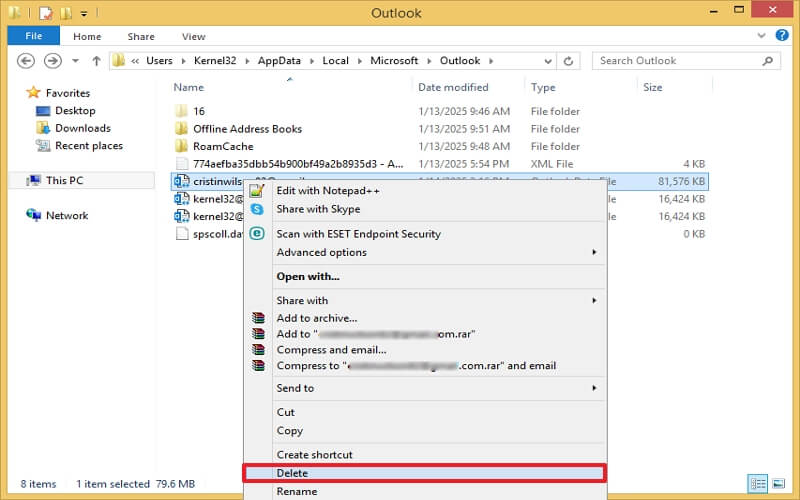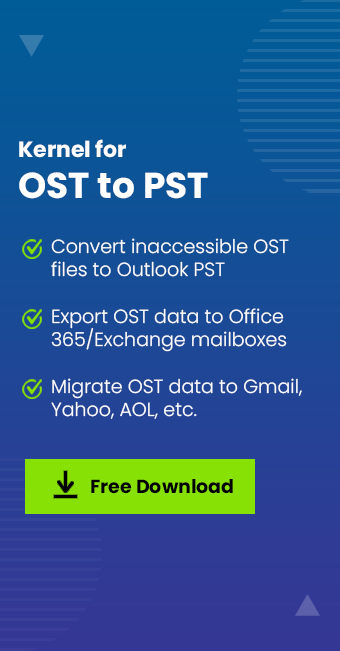Read time: 6 minutes
Outlook users should not delete their OST unless they face storage, corruption, data loss, etc. issues. The OST file stores your important mailbox data, including emails, attachments, tasks, calendars, etc., and serves as a local cache. It also synchronizes the data with the Exchange server and provides offline accessibility to the users.
Instead, it is also possible to delete OST files unknowingly, but it may create other severe problems such as offline accessibility, data loss, and many others. So, it is crucial to analyze the consequences after deleting Outlook OST file. Let’s discuss the significant reasons, pros-cons, precautions, and safe ways to delete OST files, respectively.
Why delete Outlook OST Files?
There could be several reasons but below are some major factors that compel users to delete an OST file. These are:
- Virus/Malware Infection: When the OST file gets virus/malware infected, it becomes a necessary step to delete them from your device.
- Storage Management: The OST file size gets oversized over time so, to manage and free up the space, OST file deletion is required.
- Corruption in Outlook: Corruption in OST file disrupts the workflow and productivity. So, deleting OST files becomes crucial to deal with corruption issues.
- Fixing Synchronization Issues: When you encounter synchronization issues with Exchange mailbox, your Outlook behaves inappropriately. To fix sync issue, the need to delete OST file Outlook emerges.
- Retrieve Outdated or Missing OST Data: When Outlook connects with the Exchange server then Outlook creates the OST file again and synchronizes the data accurately. To retrieve the old or missing data again from Exchange server, users might consider OST deletion.
Now, let’s know what issue you will face after deleting OST files Outlook.
What Happens After Deleting Outlook OST Files?
When the user deletes OST file and connects the Outlook to the Exchange server, the Outlook again recreates a new OST file. Here, we will analyze the other different after-effects of deleting OST files. Go through the below pointers respectively:
- Disrupts Offline Access: After deleting OST files, you may not be able to access your access data until Outlook creates and synchronizes the data. It may be time-consuming depending upon the mailbox size and may affect your communications until completion.
- Short-term Data Loss: You might temporarily lose your mailbox items, including email, contacts, attachments, etc., stored in your local storage when you delete Outlook OST files.
- Loss of Offline Changes in OST File: The changes in OST file and caches will be lost which you’ve made in the unavailability of the internet or offline.
- Synchronization Error: You may also face other issues in Outlook along with synchronization issues with the Exchange server.
How to Delete OST File Outlook Easily?
Deleting Outlook OST files is not a tough job. But before doing the same, make your internet connection stable, which helps you to get your data again in a new OST file. After this, follow the steps below:
- Close Outlook application and go to the below mentioned location in your File Explorer.
For Outlook 2013, 2016, and 2019: C:\Users\username\AppData\Local\Microsoft\Outlook
For Outlook 2010: My Documents\Outlook Files for Windows XP, and Documents\ Outlook File
For Outlook 2007: C:\Users\username\AppData\Local\Microsoft\Outlook
Note: These paths will work for Windows Vista, Windows 7, Windows 8, Windows 10, and Windows 10.
- Now, look for the OST file you want to delete, right-click on that and select Delete option.

The OST file will be deleted. After this, restart your Outlook again. You will find that a new OST file will be recreated.
Precautions Before Deleting Outlook OST Files
As per the above discussion, Outlook may get into severe problems, and you may face many issues after deleting Outlook OST files. So, do follow the below precautions before deleting Outlook OST file:
- Try to repair OST file if corrupted.
- Make sure that you’re connected to Exchange to get your data again in the new OST file.
- Backup OST files to escape the data loss issues.
The above precautions are necessary to maintain your workflow and communication again. However, when the OST file seems to be corrupted, and you want to take backup before deleting, you may face inconveniences due to manual procedure for the same. Although, manual procedures also come with their risks and limitations that may damage your data file.
Thus, do consider the Kernel for OST to PST Converter software to repair, recover, and backup your OST file easily. It can also recover all your OST data, including emails, attachments, tasks, calendars, along with deleted items. This OST to PST converter tool is easy to use and effective software to backup OST data in PST, EML, MSG, MBOX, PDF, HTML, etc. You can also migrate your OST data directly to different servers like Exchange, Domino, etc.
Summing Up
To wrap up, we helped you understand the prime reasons and consequences for deleting Outlook OST files. Also, we’ve got the precautions and guide on how to delete OST files safely. However, OST backup is crucial, so avoid the manual guidance and go for the suggested automated and secure OST to PST converter software to convert OST file to PST and save your time. If the OST file is large, you can split it into multiple small PST files along with the original hierarchy and integrity of the data. Get the trial version now to experience the efficiency of the software.
FAQs
A- After deleting OST file, when you open Outlook, it again creates a new OST file and synchronizes to Exchange server. It may also take time depending on your mailbox size system configuration.
A- Yes, when Outlook connects with Exchange server or mail serve, the data gets automatically stored in new OST file. In case the data is not restored, use the OST to PST converter tool to backup and recover all your OST data including deleted items effectively.
A- You can recover your deleted emails in 30 days, but after that, you need professional software to recover your deleted OST email items.
A- Yes, it is recommended to keep a backup of OST file before performing deletion procedure to get away from the data loss issues.







![Different easy methods to backup OST files [2024]](https://www.nucleustechnologies.com/blog/wp-content/uploads/2021/07/backup-ost-file.jpg)